Escalation…
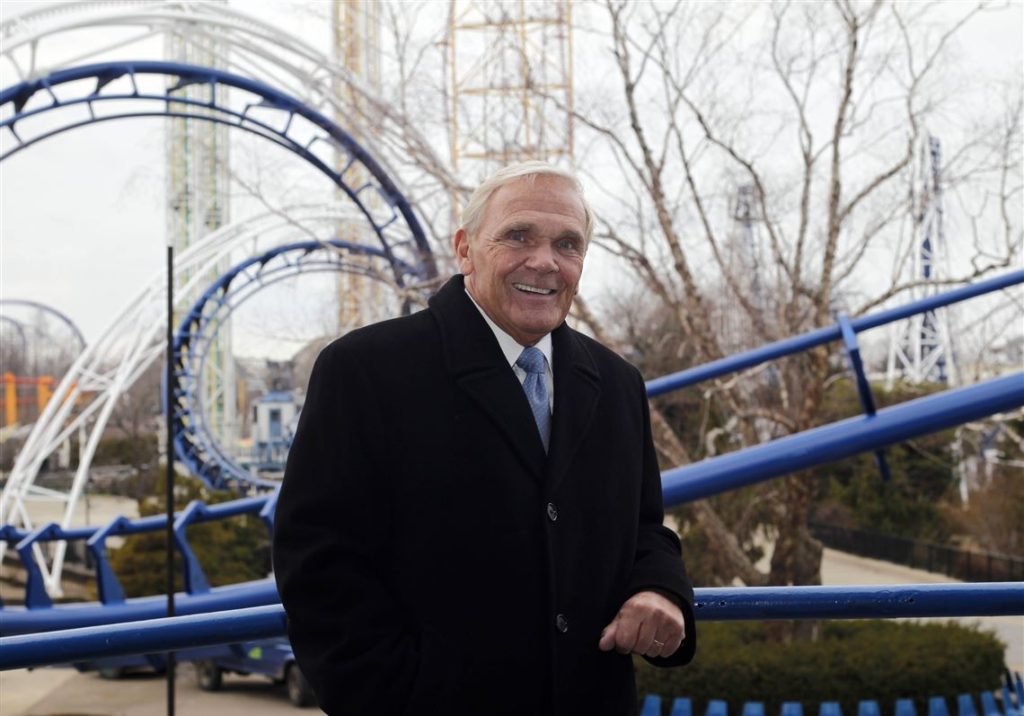
There’s probably no single person as inherently tied to the Coaster Wars of the ‘90s and early 2000s as then-CEO of Cedar Fair, Dick Kinzel. Serving as the company’s chief since 1986 (and thus, overseeing the record-breaking developments of both Magnum XL-200 and Millennium Force), Kinzel’s vision for the growing family of Cedar Fair parks was clear: building bigger, taller, and faster.
It makes sense. With B&M and Intamin as weapons dealers in the escalating arms race between regional parks, coaster lineups reaching ten or more coasters became increasingly standard across Cedar Fair and Six Flags parks – each vying for regional “staycation” summer dollars.
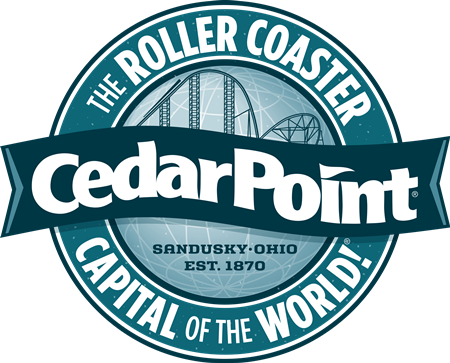
For fans across early 2000s discussion boards, speculation ran rampant on what each park would announce next, whether B&M or Intamin reigned supreme, and who would ultimately control the “Roller Coaster Capital of the World” moniker. With the opening of Millennium Force, Cedar Point offered a lineup of 14 coasters – the largest collection on Earth, with Six Flags Magic Mountain hot on its tail.
(It should be noted that Kinzel’s somewhat singular focus on thrills over just about anything else wasn’t without controversy. His extraordinary focus on the Coaster Wars arguably saw Cedar Fair’s legacy parks – and then its acquired parks, like Knott’s Berry Farm, the Paramount Parks, and the Lost Legend: Geauga Lake – develop decades of dependency on “extreme thrills” over just about anything else. Cedar Fair’s legacy parks have zero – zero! – dark rides between them, and ride lineups absent “mid-sized” coasters, flat-rides, or theming are frequent. Only Kinzel’s replacement with former Disneyland President Matt Ouimet in 2013 started to see some family flavor added back into Cedar Fair parks.)
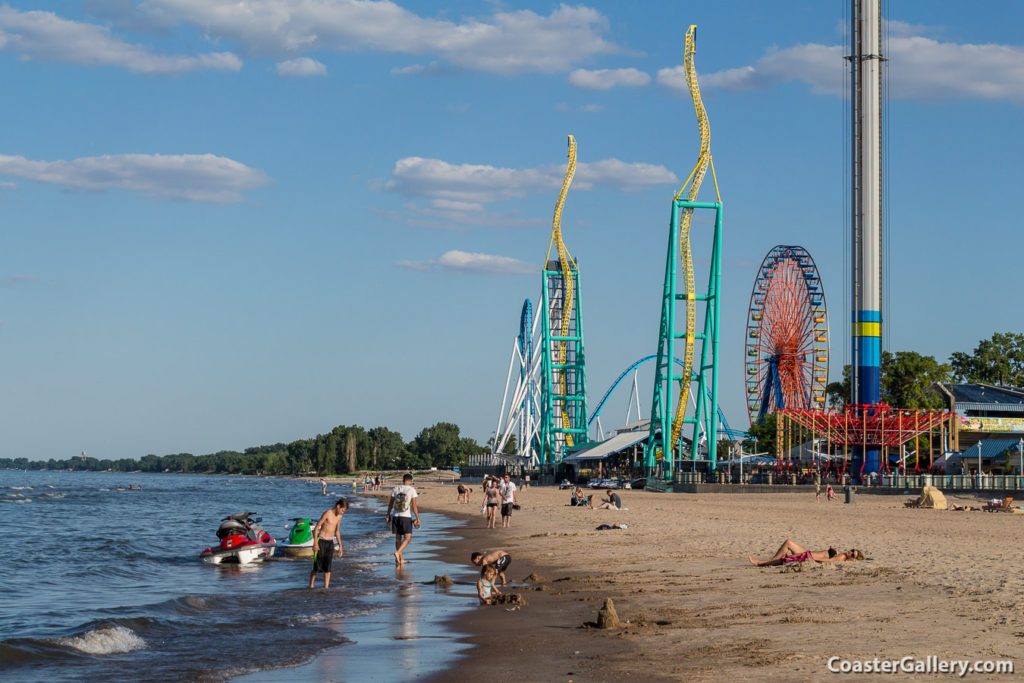
The proliferation of Cedar Point coasters continued. In 2002 – just two years after Millennium Force’s debut – Cedar Point introduced Wicked Twister. The fifth of six Intamin Impulse coasters built between 2000 and 2003, the double-spiked-tower shuttle coaster was a mid-sized, compact addition to the park’s beachfront. But for reasons that will soon become clear (if they aren’t already), it’s also worth digging into the technology that made this mid-sized coaster work…
Acceleration
Once-upon-a-time, the only ways to get roller coasters to launch were to either connect a train to a cable and drop a heavy counterweight (as is what happened in many classic Schwarzkopf shuttle loopers) or to use spinning drive tires to mechanically propel trains from a stop. Both processes, of course, are mechanical ones – subject to friction, wear-and-tear, and other frustrating limitations imposed by the physics of contact force.
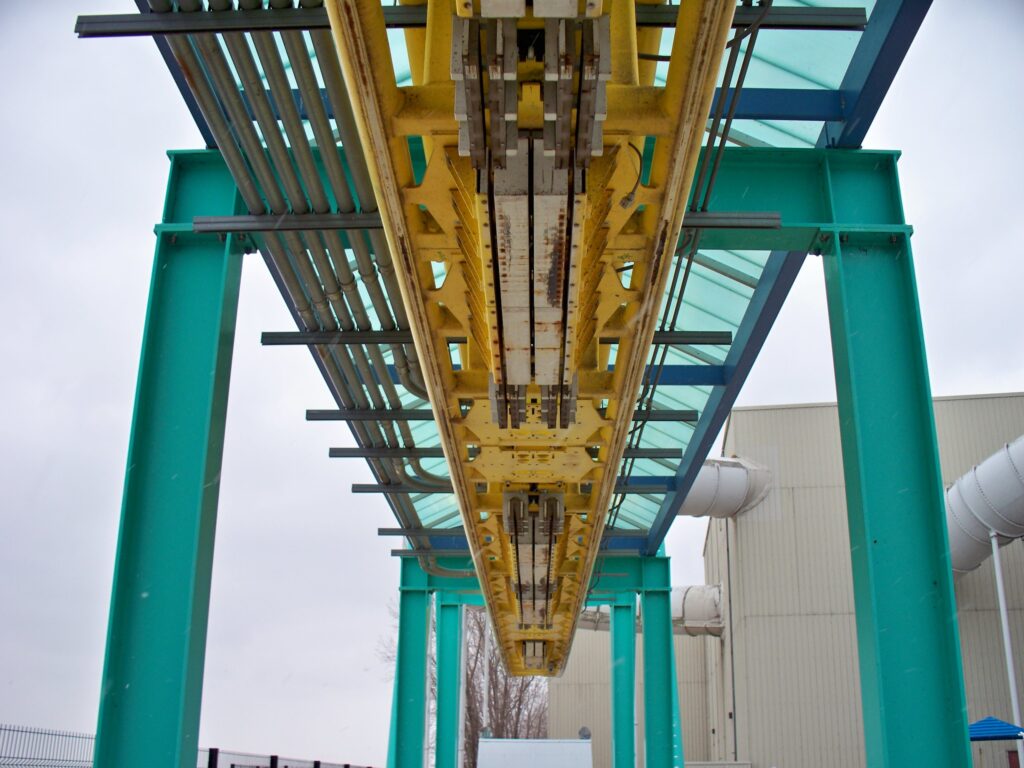
But Wicked Twister brought to Cedar Point a new kind of launch, provided by linear induction motors, or “LIMs.” They and their successor, linear synchronous motors (LSMs), work off of a very different system: electromagnetism. On LIM and LSM coasters, the track is lined by electrical motors (above). When they’re powered on by being supplies with electricity, they produce a pleasant electrical “hum” as they generate electromagnetic fields – a non-contact force.
That, in turn, activates the electromagnetic properties of narrow aluminum “fins” affixed to coaster trains, magnetically attracting those fins in through narrow slits in the motors, and repelling them out the other side. “Gradually” in a physics sense (but experientially, in the span of just a few seconds), the attract-repel-attract-repel of each fin in each successive motor produces a launch… and with no moving parts and no contact, meaning no friction or wear-and-tear!
Most assumed that the park’s 15th coaster was merely a dessert after the entree of Millennium Force. It turned out, though, that Wicked Twister was actually the appetizer for something bigger.
So you can imagine that with Millennium Force paving the way, Cedar Fair was already in discussions with Intamin about what would come next… And though 11 year gaps had separated Cedar Point’s 100-, 200-, and 300-foot installations, the unthinkable 400-foot barrier would fall much sooner than anyone thought thanks to Intamin’s experiments in acceleration…
The same summer that Cedar Point opened Wicked Twister, the company opened Xcelerator at Knott’s Berry Farm. Rather than the relatively gradual, electromagnetic acceleration provided by LIM and LSM technology (like on Wicked Twister), Xcelerator was the first of an entirely new Intamin ride model.
Deemed an “Accelerator” coaster, Xcelerator employed the use of a hydraulic launch. Trust us, it’s complicated, but in short, Intamin’s hydraulic launch system used a massive drum serving as a spool for a metal cable. When hydraulic fluid exerted to extreme pressure is suddenly released, the drum would spin, “reeling in” the cable – which is winched onto the bottom of the coaster train, “pulling” it at near-instantaneous top speed. Xcelerator’s hydraulic system provided a notably different experience than “gradual” acceleration of the LIM / LSM systems, launching riders from 0 to 82 miles per hour in just 2.3 seconds.
As a prototype of Intamin’s next boundary-pushing ride technology, Xcelerator was a success. But it was also a test track for something more. Before the ride opened to the public, several interesting tests were run on the ride, dialing up its capabilities and launching the ride at speeds far higher than it would ever operate with riders – reportedly, up to 117 miles per hour.
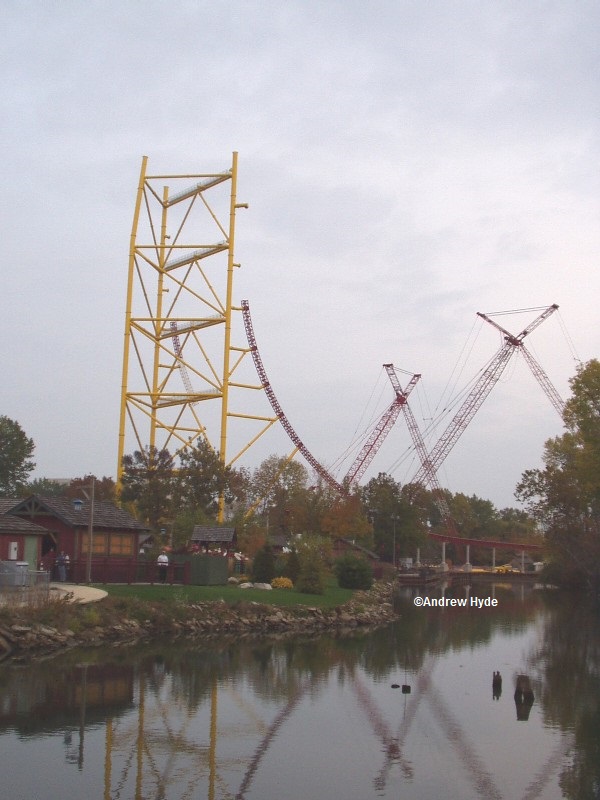
So when a few accessory ride relocations, land clearing, and some conspicuous concrete footers appeared along Cedar Point’s midway, message boards were alight with rumors… of course, speculation shifted into overdrive when – on August 21, 2002 – the blazing yellow supports and cherry red track of an Intamin Accelerator model were dropped off at Cedar Point’s front door.
By time the park closed for the season (essentially halting coverage), those pieces had been assembled into the climb into and pull-out of a vertical launch tower just like Xcelerator’s. But without any official word from the park, no one knew exactly what form Cedar Point’s version of a hydraulic launch coaster would take…
Then, on January 9, 2003, it was official. Top Thrill Dragster wouldn’t just give Cedar Point the world’s second hydraulically-launched coaster; it would obliterate the unthinkable 400-foot height barrier, just three years after the world’s first 300-foot full circuit coaster debuted across the park. It seemed absolutely impossible. Yet it was real…
Baby, I’m Ready To Go

Top Thrill Dragster – Cedar Point’s $25 million, record-breaking, cloud-piercing roller coaster – officially opened on May 4, 2003. Only Dragster’s hot-rod-red top hat could best Millennium Force as the icon of Cedar Point’s skyline. From every angle, it’s a landmark; the world’s tallest and fastest roller coaster; the first and only to race past the unthinkable 400-foot height barrier; the apex of the Coaster Wars.
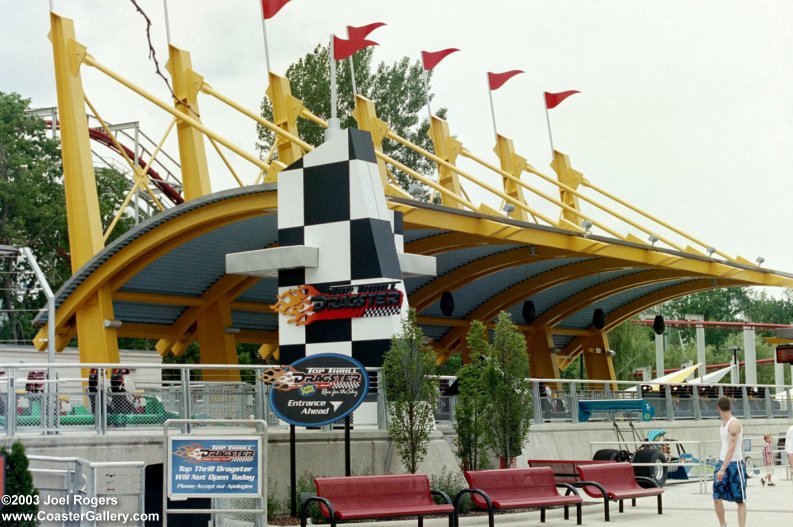
It all begins along the park’s mid-century midway. There – where Arrow’s Corkscrew was the first coaster to feature three inversions, and where Arrow’s Gemini once left riders shook with its 100-foot height – a new, sleek, flag-lined station gives onlookers a glimpse into the eyes of guests as they shuffle into hot rod trains and roll out into the sun and parks before a grandstand of metal bleachers.
There, onlookers await with baited breath and cameras poised to capture the moment… The track hisses as the train rolls back into place… A race light illuminates red… And…
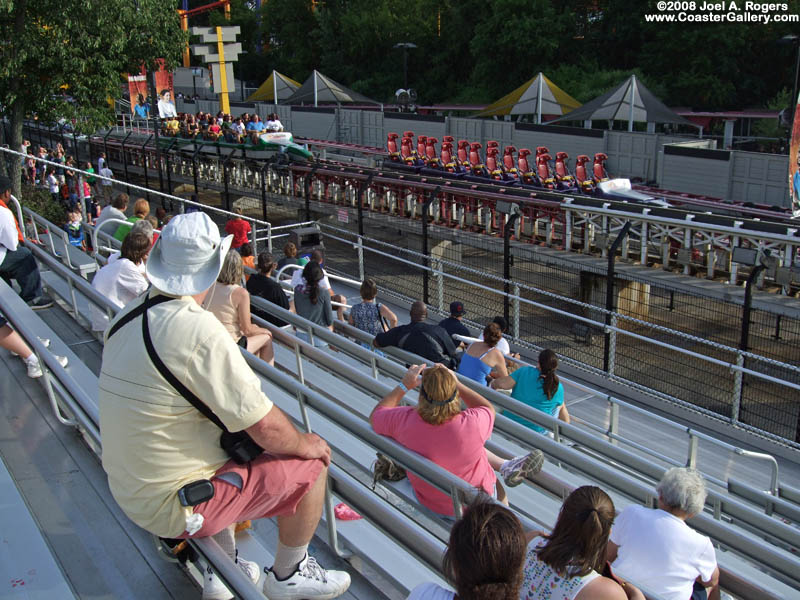
You know, with rides like this, sometimes it’s better not to watch, but to pull off the Band-aid and just get in line. The entrance to Top Thrill Dragster is further up that straightaway, so chances are that you’ll pass directly beneath a train as it accelerates by, peeling up and racing skyward. The queue is simple – a series of switchbacks nestled between the ride’s launch and brake, perhaps making you feel like you’re part of the pit crew.
But as you draw closer and closer to the station, the reality of that number – 120 miles per hour in four seconds – sets in. Sure, you’ve probably been on a launched coaster. It might’ve even been one of the industry’s newer systems, like linear induction motors that use non-contact electromagnetism to attract-and-repel trains through lined electric motors, like the park’s own Wicked Twister. But this is something new entirely. On Top Thrill Dragster, you’re not pushed; you’re pulled.
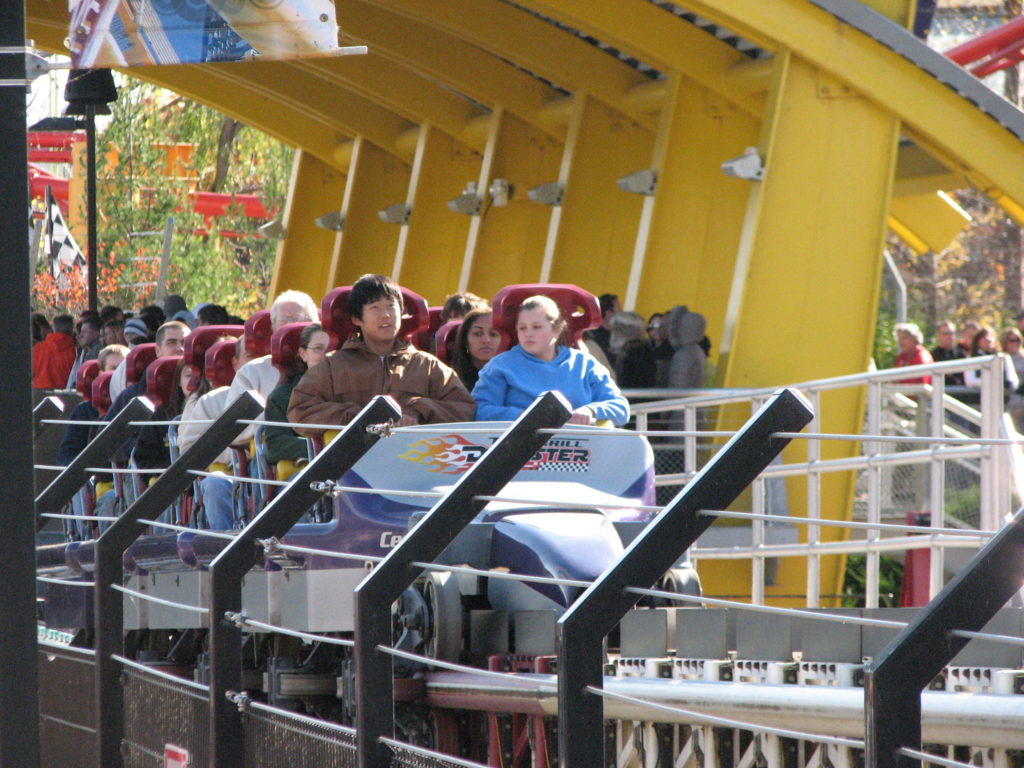
Sit down. Buckle up. Pull down that lap-bar, all to the tune of Republica’s “Ready To Go.” Once you’re seated, your train rolls out of the station and lumbers to a stop at the starting line. It’s a nail-biting moment, but you won’t want to bite your nails. It could happen at any second. Don’t blink. Don’t breathe. Don’t look to your left or right. Whatever you’re doing when the ride launches, you’ll be stuck doing it down the length of the straightaway. As crowds look on, cameras ready, the brakes hiss and release, the train rolling back a few inches or so.
Underneath, a cable has attached to your dragster’s catch car. The physics and mechanics behind Top Thrill Dragster are incredibly complex, but suffice it to say that this launch system means business. 48,000 pounds of force provided by 32 hydraulic motors power a massive rotating drum that unwinds the launch cable at 9 rotations per second. And that leaves you as the subject of one of the world’s most extraordinary science experiments.
“Arms down, head back, and hold on,” a voice repeats until all riders comply. Then… you wait…
And wait…
And wait…
Eyes darting between the stop light and the tower, waiting for that red light to cascade down into a series of yellows and then, green… When will it happen?
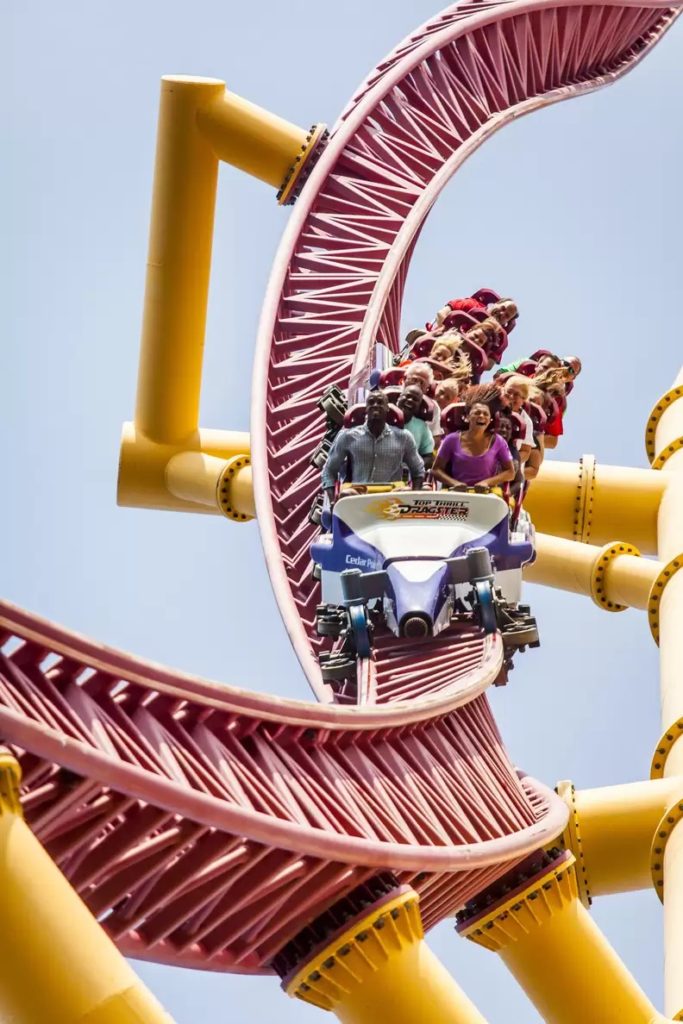
Before you can process, it’s underway. The initial acceleration seems to happen before the sound of the tires can even reach you. Unlike the “gradual” (albeit, very quick) acceleration of electromagnetism, this calculated, synchronous release of the ride’s tension-filled launch cable is instantaneous. In an instant, you’re gone. Within four seconds, the 17 ton train is traveling 120 miles per hour, practically levitating over the track as wind-whipping, chest-pressing pressure bolts riders into their seats. This is the equivalent of jumping to light speed; a sustained, steady acceleration you feel in your soul.
The second the launch cable detaches, the train blasts upward, pulling up into a vertical track with a 90-degree spiral twist that aligns riders with the crest of the top hat. The seconds spent here – 420 feet over Lake Erie – make Millennium Force look like a kiddie coaster. But there’s no time to sightsee. Tipping over the top-hats half-way point, the train dives vertically, plunging through a 270-degree spinning spiral before aligning once more with terra firma. The 400 foot, 112 mph plunge at last aligns with a horizontal straightaway, and in a flash, the train careens beneath the Finish Line marquee.
From launch to deceleration, Top Thrill Dragster is just 17 seconds of high-octane insanity. And though calmer heads will eventually prevail, in those elated moments when the train pulls into the unload area, you’d be forgiven for believing that that 17 second ride is perhaps the best roller coaster on Earth – an undeniable experience that every thrill-seeker should put atop their “bucket lists.”
Top Thrill Dragster was the tallest, fastest roller coaster on Earth – and by nature of its design, a one-of-a-kind ride experience. For that alone, it’s no surprise that the ride earned rave reviews and instantly became a must-ride icon of the Coaster Wars. In other words, it worked. Cedar Point’s record-breaking ride – requiring the invention of the 400-foot “stratocoaster” moniker – was the “Would you or wouldn’t you?” across news stations and water coolers; the coaster equivalent of Survivor.
In fact, about the only person who didn’t want to talk about Top Thrill Dragster was Dick Kinzel. Just as Oppenheimer regretted his role as the “father of the atomic bomb,” Kinzel seemed to have recognized that at his behest, the Coaster Wars had officially gone too far. How so? Read on…



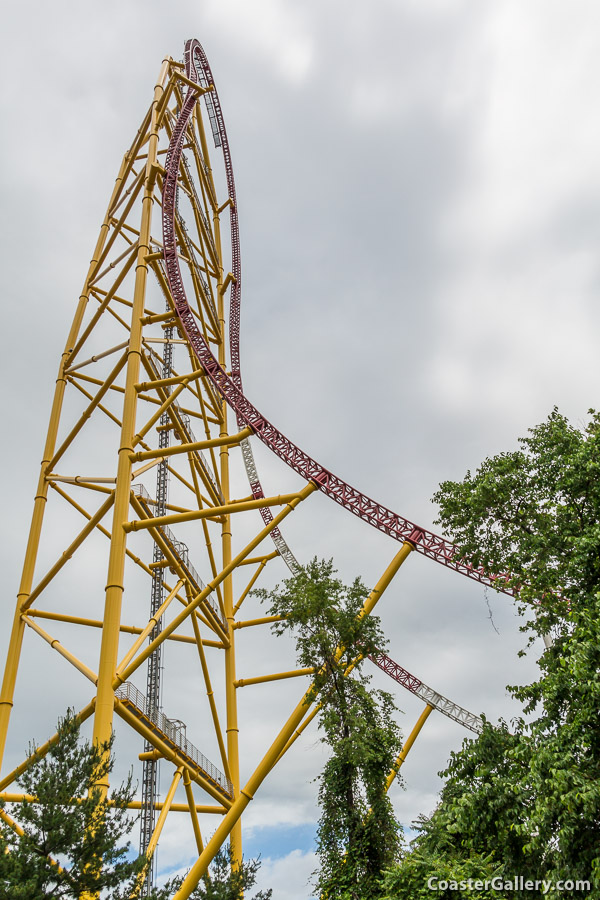
I think this article deserves an update that mentions the debacle of the past three months. Though maybe that should wait until we actually know something…
Hopefully the story will have a happy ending, and this doesn’t get moved into Lost Legends.
Exactly my strategy! Holding off until we have a clear idea of the next chapter… What a mess. Thanks for reading!